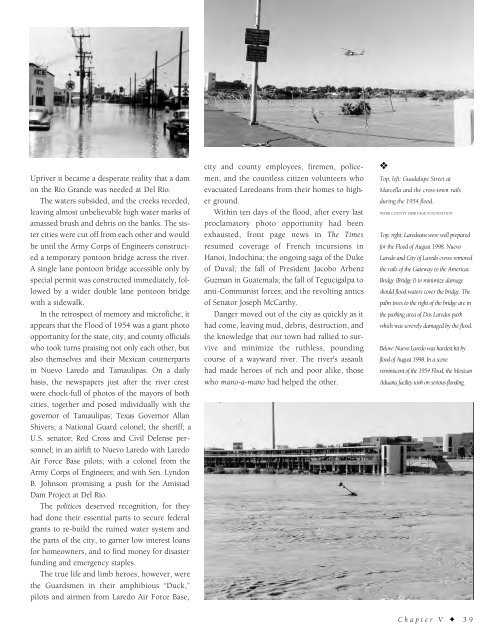Historic Laredo
An illustrated history of the city of Laredo and the Webb County area, paired with the histories of companies, families and organizations that make the region great.
An illustrated history of the city of Laredo and the Webb County area, paired with the histories of companies, families and organizations that make the region great.
Create successful ePaper yourself
Turn your PDF publications into a flip-book with our unique Google optimized e-Paper software.
Upriver it became a desperate reality that a dam<br />
on the Río Grande was needed at Del Río.<br />
The waters subsided, and the creeks receded,<br />
leaving almost unbelievable high water marks of<br />
amassed brush and debris on the banks. The sister<br />
cities were cut off from each other and would<br />
be until the Army Corps of Engineers constructed<br />
a temporary pontoon bridge across the river.<br />
A single lane pontoon bridge accessible only by<br />
special permit was constructed immediately, followed<br />
by a wider double lane pontoon bridge<br />
with a sidewalk.<br />
In the retrospect of memory and microfiche, it<br />
appears that the Flood of 1954 was a giant photo<br />
opportunity for the state, city, and county officials<br />
who took turns praising not only each other, but<br />
also themselves and their Mexican counterparts<br />
in Nuevo <strong>Laredo</strong> and Tamaulipas. On a daily<br />
basis, the newspapers just after the river crest<br />
were chock-full of photos of the mayors of both<br />
cities, together and posed individually with the<br />
governor of Tamaulipas; Texas Governor Allan<br />
Shivers; a National Guard colonel; the sheriff; a<br />
U.S. senator; Red Cross and Civil Defense personnel;<br />
in an airlift to Nuevo <strong>Laredo</strong> with <strong>Laredo</strong><br />
Air Force Base pilots; with a colonel from the<br />
Army Corps of Engineers; and with Sen. Lyndon<br />
B. Johnson promising a push for the Amistad<br />
Dam Project at Del Río.<br />
The políticos deserved recognition, for they<br />
had done their essential parts to secure federal<br />
grants to re-build the ruined water system and<br />
the parts of the city, to garner low interest loans<br />
for homeowners, and to find money for disaster<br />
funding and emergency staples.<br />
The true life and limb heroes, however, were<br />
the Guardsmen in their amphibious “Duck,”<br />
pilots and airmen from <strong>Laredo</strong> Air Force Base,<br />
city and county employees, firemen, policemen,<br />
and the countless citizen volunteers who<br />
evacuated <strong>Laredo</strong>ans from their homes to higher<br />
ground.<br />
Within ten days of the flood, after every last<br />
proclamatory photo opportunity had been<br />
exhausted, front page news in The Times<br />
resumed coverage of French incursions in<br />
Hanoi, Indochina; the ongoing saga of the Duke<br />
of Duval; the fall of President Jacobo Arbenz<br />
Guzman in Guatemala; the fall of Tegucigalpa to<br />
anti-Communist forces; and the revolting antics<br />
of Senator Joseph McCarthy.<br />
Danger moved out of the city as quickly as it<br />
had come, leaving mud, debris, destruction, and<br />
the knowledge that our town had rallied to survive<br />
and minimize the ruthless, pounding<br />
course of a wayward river. The river's assault<br />
had made heroes of rich and poor alike, those<br />
who mano-a-mano had helped the other.<br />
❖<br />
Top, left: Guadalupe Street at<br />
Marcella and the cross-town rails<br />
during the 1954 flood.<br />
WEBB COUNTY HERITAGE FOUNDATION<br />
Top, right: <strong>Laredo</strong>ans were well prepared<br />
for the Flood of August 1998. Nuevo<br />
<strong>Laredo</strong> and City of <strong>Laredo</strong> crews removed<br />
the rails of the Gateway to the Americas<br />
Bridge (Bridge I) to minimize damage<br />
should flood waters cover the bridge. The<br />
palm trees to the right of the bridge are in<br />
the parking area of Dos <strong>Laredo</strong>s park<br />
which was severely damaged by the flood.<br />
Below: Nuevo <strong>Laredo</strong> was hardest hit by<br />
flood of August 1998. In a scene<br />
reminiscent of the 1954 Flood, the Mexican<br />
Aduana facility took on serious flooding.<br />
Chapter V ✦ 39
















